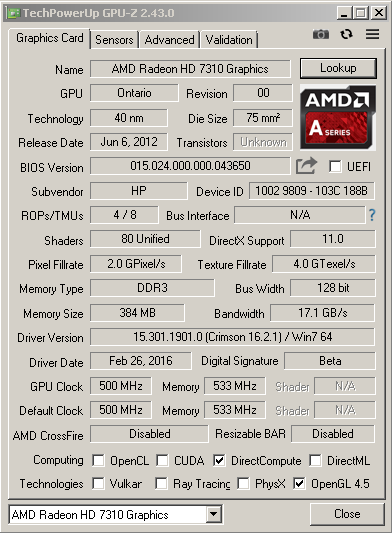CrystalDiskMark score Read: 393.23 MB/s Write: 393.66 MB/s with a Radeon HD 7310 IGPU VRAM Disk
Thursday, 01 January 1970 07:00 | Update at null
Media Gallery
Screenshot

Device, Setup, etc


URL
https://www.facebook.com/hakimnu.id/posts/pfbid0bMLfD8eTQ5u7m9XnQ7qpzpPP6BwxdUsfpQgLnnfJULE2rB5WPaJQe6Fu23XaFZKvlInformation Detail
Hardware: AMD Radeon HD 7310 IGPU VRAM Disk
Specs:VRAM Total Capacity : 384MB + SHARED
VRAM Disk Capacity : 128MB
Brand : -
Frequency : -
Bus Width : 128bit
Memory Type : DDR3
Configure : -
Software : GPU RAM Drive
Interface : IGPU
Form Factor : IGPU
TBW : -
DRAM Cache : -
See more specification...
Software: CrystalDiskMark
Seq Read: 393.23 MB/s
Seq Write: 393.66 MB/s
About: CrystalDiskMarkCrystalDiskMark is a simple disk benchmark software.
The AMD Radeon HD 7310 is an integrated GPU (iGPU) based on the Terascale 2 architecture embedded in some early generation E1 series APUs, such as the AMD E1-1200. With 80 Stream Processors, this GPU is designed for light tasks such as video playback, basic computing, and casual gaming with low graphics settings. Despite being an entry-level GPU and being quite old, the Radeon HD 7310 is still able to operate well for basic needs and certain technical experiments.
In this test using an HP 1000 1b05au device paired with an AMD E1-1200 processor, 4GB DDR3 RAM, and Windows 7 operating system, an interesting experiment was conducted by converting part of the VRAM allocation into a VRAMDisk using specialized GPU RAM Drive software.
VRAMDisk is a method that utilizes VRAM capacity as high-speed temporary storage, just like RAMDisk but with graphics memory. In this configuration, of the total VRAM of 384MB (plus shared memory), about 128MB was set aside to be used as a VRAMDisk. Despite the small capacity, the read and write speeds were quite surprising:
- CrystalDiskMark:
- Read: 393.23 MB/s
- Write: 393.66 MB/s
This figure shows that even using an older generation GPU with DDR3 memory and a 128-bit interface, the VRAM still has enough bandwidth for light cache tasks or fast storage experiments. This technology is not intended for daily use, but it can be an interesting alternative for technical purposes, testing, or short-term local access speeds of small files.
Given its limitations-both in terms of VRAM capacity, iGPU performance, and modern driver support-the AMD Radeon HD 7310 is definitely not an option for gaming or heavy workloads right now. However, experiments like this VRAMDisk show that legacy devices can still be creatively utilized in certain contexts, especially in resource-constrained environments.
Device test (testbed) :
Device: HP 1000 1b05au
Software: GPU Ram Drive
CPU: AMD E1-1200
GPU: AMD Radeon HD 7310 (Integrated)
RAM: 4GB DDR3 Single Channel 2 DIMM 1066MHz
OS: Windows 7
* Not Avaiable
